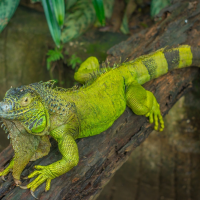
Table of Contents
Four-Eyed Opossum: Quick Facts
- Scientific Name: Philander opossum
- Family: Didelphidae
- Habitat: Tropical and subtropical forests, wetlands, and savannas
- Diet: Omnivorous (fruits, insects, small vertebrates, and invertebrates)
- Lifespan: Approximately 2-4 years in the wild
- Size: 30-45 cm in body length, with a tail length of 30-40 cm
- Weight: 200-700 grams
History & Origin
The four-eyed opossum sometimes known as the Philander opossum is an intriguing marsupial native to Central and South America. Its distribution stretches from southern Mexico to Central America to northern Argentina and Uruguay. This species is called after the conspicuous white patches above its eyes which give the illusion of four eyes. The four-eyed opossum is a member of the Didelphidae family which is the biggest group of marsupials in the Western Hemisphere and includes several opossum species.

Physical characteristics
The four-eyed opossum is a medium-sized mammal with a lean, agile build. Its body length ranges from 30 to 45 cm with an extra 30 to 40 cm for the prehensile tail. Adults weigh between 200 and 700 grams. The most distinguishing feature of this opossum is a pair of white or cream-colored patches over each eye which resemble a second pair of eyes. Its fur is mostly grayish-brown on the back and sides with a brighter typically white, underbelly. The tail is sparingly furred and prehensile which helps climb and grasp trees.
Temperament and Personality
Four-eyed opossums are nocturnal solitary creatures famed for their secrecy and elusiveness. They are predominantly arboreal but will descend to the ground to forage for food. These opossums are highly adaptable and may live in a wide range of settings including woods marshes and even places near human settlements. Despite their solitary nature they are highly noisy communicating through a variety of sounds such as clicks, hisses, and growls. In captivity they may develop more acclimated to human interaction but they remain wary and independent.
Exercise and Activity Needs
As nocturnal species four-eyed opossums are most active at night. They require a habitat that provides many opportunity for climbing and exploration similar to their natural arboreal home. In the wild they travel long distances in search of food using their prehensile tails and strong claws to negotiate trees and dense vegetation. If kept in captivity a large cage with enough of vertical space, branches and hiding places is necessary for keeping them physically and psychologically occupied. Regular exercise helps avoid obesity and promotes general health.

Grooming Needs
Four-eyed opossums are largely self-sufficient in terms of grooming. They keep their fur clean by licking and grooming on a regular basis. They do not require frequent bathing in captivity but their living conditions should be kept clean to avoid health problems. Providing a balanced food and access to clean water is critical for their health and well-being. Regular check-ups with a marsupial-experienced veterinarian can help monitor their health and handle any issues that arise quickly.
Health and Common Concerns
In the wild four-eyed opossums suffer a number of hazards, including predation habitat degradation and human activity. If they are not adequately treated for in captivity they can develop dietary shortages dental difficulties and stress-related diseases. To achieve their nutritional requirements they must consume a diverse diet that includes fruits, insects, and small vertebrates. Regular veterinary check-ups can help identify and address problems early. Providing a clean and enriched atmosphere also aids in the prevention of common health issues such as parasite infections and gastrointestinal difficulties.
Training and socialization
While four-eyed opossums are not commonly kept as pets they can be trained to some extent, particularly when young. Early socialization and positive reinforcement strategies like as providing treats and praise might help them feel more at ease with human interaction. Training should concentrate on basic handling and acclimating them to their captive habitat. However it is critical to respect their natural habits and avoid attempting to entirely domesticate then as they maintain many of their wild instincts. Providing mental stimulation through environmental enrichment, puzzles, and interactive toys is critical for keeping kids mentally engaged and reducing stress.

Conclusion
The four-eyed opossum is a fascinating mammal with distinct physical features and personality. Whether seen in the wild or kept in captivity these animals enchant with their secretive and independent nature. Understanding their requirements and behaviors is critical to their conservation and well-being. By giving proper care, stimulation and respect for their natural impulses, we can ensure that these interesting species thrive in their natural habitats as well as in surroundings where they are studied and enjoyed.
People also read about: How to Introduce a New Pet to Your Home: Tips for a Smooth Transition (Cat)
















